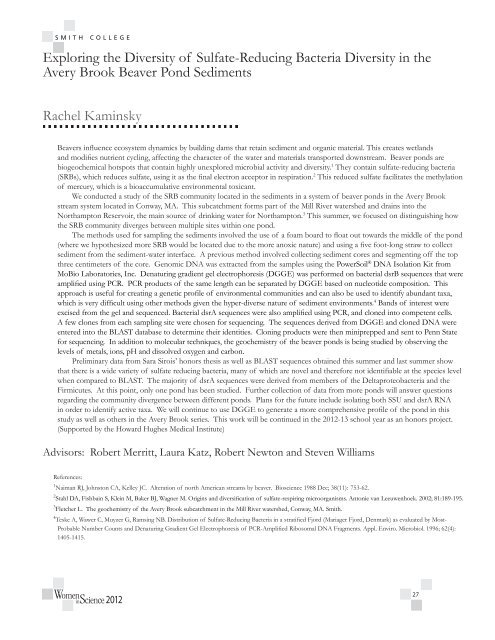Brugia Malayi - Clark Science Center - Smith College
Brugia Malayi - Clark Science Center - Smith College
Brugia Malayi - Clark Science Center - Smith College
Create successful ePaper yourself
Turn your PDF publications into a flip-book with our unique Google optimized e-Paper software.
Exploring the Diversity of Sulfate-Reducing Bacteria Diversity in the<br />
Avery Brook Beaver Pond Sediments<br />
Rachel Kaminsky<br />
Beavers influence ecosystem dynamics by building dams that retain sediment and organic material. This creates wetlands<br />
and modifies nutrient cycling, affecting the character of the water and materials transported downstream. Beaver ponds are<br />
biogeochemical hotspots that contain highly unexplored microbial activity and diversity. 1 They contain sulfate-reducing bacteria<br />
(SRBs), which reduces sulfate, using it as the final electron acceptor in respiration. 2 This reduced sulfate facilitates the methylation<br />
of mercury, which is a bioaccumulative environmental toxicant.<br />
We conducted a study of the SRB community located in the sediments in a system of beaver ponds in the Avery Brook<br />
stream system located in Conway, MA. This subcatchment forms part of the Mill River watershed and drains into the<br />
Northampton Reservoir, the main source of drinking water for Northampton. 3 This summer, we focused on distinguishing how<br />
the SRB community diverges between multiple sites within one pond.<br />
The methods used for sampling the sediments involved the use of a foam board to float out towards the middle of the pond<br />
(where we hypothesized more SRB would be located due to the more anoxic nature) and using a five foot-long straw to collect<br />
sediment from the sediment-water interface. A previous method involved collecting sediment cores and segmenting off the top<br />
three centimeters of the core. Genomic DNA was extracted from the samples using the PowerSoil ® DNA Isolation Kit from<br />
MoBio Laboratories, Inc. Denaturing gradient gel electrophoresis (DGGE) was performed on bacterial dsrB sequences that were<br />
amplified using PCR. PCR products of the same length can be separated by DGGE based on nucleotide composition. This<br />
approach is useful for creating a genetic profile of environmental communities and can also be used to identify abundant taxa,<br />
which is very difficult using other methods given the hyper-diverse nature of sediment environments. 4 Bands of interest were<br />
excised from the gel and sequenced. Bacterial dsrA sequences were also amplified using PCR, and cloned into competent cells.<br />
A few clones from each sampling site were chosen for sequencing. The sequences derived from DGGE and cloned DNA were<br />
entered into the BLAST database to determine their identities. Cloning products were then miniprepped and sent to Penn State<br />
for sequencing. In addition to molecular techniques, the geochemistry of the beaver ponds is being studied by observing the<br />
levels of metals, ions, pH and dissolved oxygen and carbon.<br />
Preliminary data from Sara Sirois’ honors thesis as well as BLAST sequences obtained this summer and last summer show<br />
that there is a wide variety of sulfate reducing bacteria, many of which are novel and therefore not identifiable at the species level<br />
when compared to BLAST. The majority of dsrA sequences were derived from members of the Deltaproteobacteria and the<br />
Firmicutes. At this point, only one pond has been studied. Further collection of data from more ponds will answer questions<br />
regarding the community divergence between different ponds. Plans for the future include isolating both SSU and dsrA RNA<br />
in order to identify active taxa. We will continue to use DGGE to generate a more comprehensive profile of the pond in this<br />
study as well as others in the Avery Brook series. This work will be continued in the 2012-13 school year as an honors project.<br />
(Supported by the Howard Hughes Medical Institute)<br />
Advisors: Robert Merritt, Laura Katz, Robert Newton and Steven Williams<br />
References:<br />
1 Naiman RJ, Johnston CA, Kelley JC. Alteration of north American streams by beaver. Bioscience 1988 Dec; 38(11): 753-62.<br />
2 Stahl DA, Fishbain S, Klein M, Baker BJ, Wagner M. Origins and diversification of sulfate-respiring microorganisms. Antonie van Leeuwenhoek. 2002; 81:189-195.<br />
3 Fletcher L. The geochemistry of the Avery Brook subcatchment in the Mill River watershed, Conway, MA. <strong>Smith</strong>.<br />
4 Teske A, Wawer C, Muyzer G, Ramsing NB. Distribution of Sulfate-Reducing Bacteria in a stratified Fjord (Mariager Fjord, Denmark) as evaluated by Most-<br />
Probable Number Counts and Denaturing Gradient Gel Electrophoresis of PCR-Amplified Ribosomal DNA Fragments. Appl. Enviro. Microbiol. 1996; 62(4):<br />
1405-1415.<br />
2012<br />
27

















